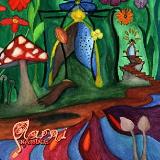|
|
||||||
|
Mixing progressive rock and funeral doom is a strange proposition, for the former seeks to challenge one's mind by presenting a complicated tapestry of interwoven melodies and patterns, always staying a step ahead of the listener, while the latter applies a constant pressure and wishes to control the mood of its subject by utilizing as few notes as possible, never seeking to impress. Then came Aarni, a one-man project from deepest Finland, to fuse the styles together. The cement that binds these opposite forces could only be the lyrics; although these dissonant musical styles share few properties, one that relates to both is the idea of awakening - progressive rock has a very intellectual reputation for good reason, being difficult to follow and frequently having lyrics which are of ambigious intent. To unlock such puzzling songs does not always come easily, and they are often solved by a revelation rather than tenacity. Funeral doom also wishes to awaken you, although it is biased and only considers you truly awakened when you have become the perfect cynic and misanthrope. Regardless of intent, each style stems from the branch of philosophy and introspection. The lyrical subjects in this case are occultism and folklore, and they are intelligently realised. Even at first glance, Bathos is an unorthodox album - its cover depicts a psychedelic scene, of which the focus is a golden arch hidden away in the woods. The art reminds me of the album covers used by the infamous space rock band Ozric Tentacles, a group of which Master Warjomaa (the only non-fictional member of Aarni) is said to be a fan. A brief introductory track featuring guitar harmonics and simple synths leads into the first real song, "Squaring the Circle", which begins with a bassline that promises a little classical epicness; the guitars oblige. The production here is not lavish, but it fails to be an issue. Before the song becomes a Candlemass cover, a heavy chord is allowed to hang in the air for a moment before the bass draws us back in. We find that although the sequence remains the same, the emphasis has changed - the guitars now only strike on the first beat of each bar and the bass refuses to define the chords. We have entered funereal territory, Skepticism-style. The track remains in much the same groove until it concludes although we are treated to an extended guitar solo - a rare occurence in funeral doom. "Quinotaurus" welcomes us with a short, modal, medieval folk song composed for bass, guitar and flute. This reminded me of Gentle Giant. It proceeds into territory already settled by Novembers Doom and Mournful Congregation but the medieval folk theme remains to the end. "Kivijumala" is the longest track in evidence, and opens with a moody guitar and bass duet which leads into another folk-inspired passage. The guitars take their cue from this, producing something which reminds me of Tristitia with flutes, even treating us to was I assumed to be a modal mellotron solo. I'll touch briefly upon the next few tracks. "V.I.T.R.I.O.L.", despite its hardcore name, is the most gentle, melancholy track so far and is entirely without percussion, although reverberating marching sounds serve as a pulse. "The Thunder, Perfect Mindfuck" has a more established riffing style and is based on a sequence that ends with a positively major cadence. Romantic Doom-Death fans take note. "Mental Fugue" opens rather confusingly, with a phasing electronic bass playing a familiar theme. This leads back to another doomy folk song which is bathed in synth. The chords that the keys pick out are at times jarring so you can never quite relax while listening to this track. "Niet Net Meru" immediately strikes the listener as something special; exotic percussion leads into an eastern style riff, over which the deep vocals are sung through a modulating filter. The egyptian feel of this song is justified by the fact that the lyrics are depicted in hieroglyphs. Being interested in word puzzles and the like, I can't help wondering if this was done for gematric purposes or merely for the image. This is a powerful song; the reviewer is completely entranced by the atmosphere, and sits here trying to fit inappropriate words like "canopic" and "mummified" into this paragraph. The final track begins with another folky, 3/4 progression, but it soon becomes evident that something more sinister is happening behind the scenes. Phasing samples are overlayed on to the sound of cawing ravens and they soon chase away the guitar players, leaving behind a strange electric waltz. This is the place where the Ozric Tentacles influence really justified itself to me, as this is a tense jam with an uncertain atmosphere. Pink Floyd may be a useful reference point to those not familiar with space rock. Perhaps this is my spaceship ride away from Egypt and back home? I would say that this was a successful experiment in avant-garde doom metal, but Master Warmojaa has been repeatedly disdainful of the term in his interviews, so I will simply say this: anyone even the least bit interested in slow but inventive music, be it doom, progressive, classical or anything else, should investigate this release. |
||||||
|
Killing Songs : Squaring the Circle, Kivijumala, Niet Net Meru |
Dee quoted 88 / 100 | |||||
|
||||||


There are 12 replies to this review. Last one on Thu Aug 23, 2007 12:53 am
View and Post comments